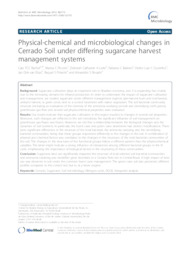Physical-chemical and microbiological changes in Cerrado Soil under differing sugarcane harvest management systems.
Physical-chemical and microbiological changes in Cerrado Soil under differing sugarcane harvest management systems.
Autoria: RACHID, C. T. C. C.; PICCOLO, M. C.; LEITE, D. C. A.; BALIEIRO, F. de C.; COUTINHO, H. L. da C.; ELSAS, J. D. van; PEIXOTO, R. S.; ROSADO, A. S.
Resumo: Abstract Background: Sugarcane cultivation plays an important role in Brazilian economy, and it is expanding fast, mainly due to the increasing demand for ethanol production. In order to understand the impact of sugarcane cultivation and management, we studied sugarcane under different management regimes (pre-harvest burn and mechanical, unburnt harvest, or green cane), next to a control treatment with native vegetation. The soil bacterial community structure (including an evaluation of the diversity of the ammonia oxidizing (amoA) and denitrifying (nirK) genes), greenhouse gas flow and several soil physicochemical properties were evaluated. Results: Our results indicate that sugarcane cultivation in this region resulted in changes in several soil properties. Moreover, such changes are reflected in the soil microbiota. No significant influence of soil management on greenhouse gas fluxes was found. However, we did find a relationship between the biological changes and the dynamics of soil nutrients. In particular, the burnt cane and green cane treatments had distinct modifications. There were significant differences in the structure of the total bacterial, the ammonia oxidizing and the denitrifying bacterial communities, being that these groups responded differently to the changes in the soil. A combination of physical and chemical factors was correlated to the changes in the structures of the total bacterial communities of the soil. The changes in the structures of the functional groups follow a different pattern than the physicochemical variables. The latter might indicate a strong influence of interactions among different bacterial groups in the N cycle, emphasizing the importance of biological factors in the structuring of these communities. Conclusion: Sugarcane land use significantly impacted the structure of total selected soil bacterial communities and ammonia oxidizing and denitrifier gene diversities in a Cerrado field site in Central Brazil. A high impact of land use was observed in soil under the common burnt cane management. The green cane soil also presented different profiles compared to the control soil, but to at a lesser degree.
Ano de publicação: 2012
Tipo de publicação: Artigo de periódico
Unidade: Embrapa Solos
Palavras-chave: Cerrado, DGGE, Integrated analysis, Soil microbiology, nitrogen cycle, sugarcane
Observações
1 - Por padrão são exibidas publicações dos últimos 20 anos. Para encontrar publicações mais antigas, configure o filtro ano de publicação, colocando o ano a partir do qual você deseja encontrar publicações. O filtro está na coluna da esquerda na busca acima.
2 - Para ler algumas publicações da Embrapa (apenas as que estão em formato ePub), é necessário ter, no celular ou computador, um desses softwares gratuitos. Sistemas Android: Google Play Livros; IOS: iBooks; Windows e Linux: software Calibre.
Acesse outras publicações
Acesse a Base de Dados da Pesquisa Agropecuária (BDPA) para consultar o acervo completo das bibliotecas da Embrapa.

